 |
||
|
||
| ||
The fact that Intel was going to equip its high-performance processors with a faster system bus wasn't a secret a long time ago already. First it was confirmed by VIA which had nothing to lose on the field of Pentium 4 chipsets. The P4X266A chipset, released yet at the end of the last year, sported the support of future processors with the 533 MHz bus. With time Intel's plans got more clear; and in April, by the release of the new CPUs, we saw SiS coming onto the scene. However, it couldn't bust up with Intel, that is why in the documentation for the SiS 645DX the figure 533 was followed by the word "Overclock". Today the great mystery is made known, and we can examine the new processors with the chipsets which as if appeared just now. But this "sudden" abundance does not close the subject of the new chipsets, it will be continued in a couple of weeks. Available chipsetsThe announced line includes the most interesting model clocked at 2.4 GHz which is marked as "2.4B GHz" so that it isn't confused with a model of the same frequency but with the 400MB bus. Earlier it was supposed that the 2.4B GHz must be the top in the line, but at the last moment the 2.53GHz version became the one. It seems that Intel strengthens the existent gap between its processors and top AMD models. 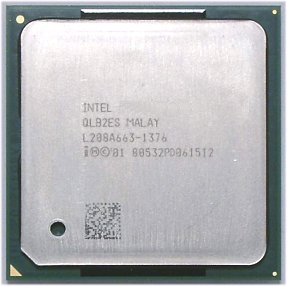 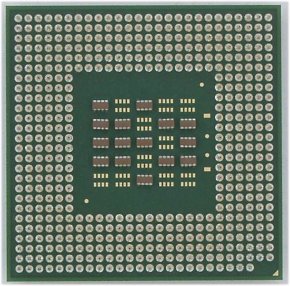 Now let's turn to the chipsets. VIA P4X266AWe reviewed this chipset yet in December. The modern boards based on it come with the most advanced south bridge of the old series — VT8233A, which supports ATA133, but lacks for USB 2.0. The north bridge didn't change since its announcement. But because a modern board must be obligatory coupled with the USB 2.0 (it gets it with an additional controller) and the DDR333 (the DDR333 specification is at last approved by JEDEC), nobody restricts to set the memory frequency at 166(333) MHz in the BIOS without detriment to other buses; fortunately, the chipset provides it. The VIA P4X266A is thus not a hi-end solution, but a board on it can be an excellent base for a powerful computer with an attractive support of all types of the Pentium 4 at a relatively low price. SiS 645DXIt's not easy to find differences with the SiS 645 chipset at first glance: it supports the Pentium 4 on the 533 MHz bus and DDR400 memory, but all these features are marked as "Overclock" in the documentation, and such overclocking is not surprising today — for example, the Abit SD7-533 which was already examined allowed for both things. I just don't understand the difference between overclocking and other standard special modes if adjustments are available in the BIOS, and all other buses (except the overclocked one) run at their rated frequencies and stability doesn't get worse. So, are there any real changes in the north bridge or they just add "DX" to the name starting from a certain figure? 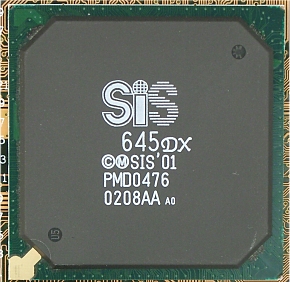 The south bridge isn't less mysterious. The documentation says that the chip-companion of the SiS 645DX is SiS 962. But they actually use the SiS 961 rev.B as a south bridge which differs from the old revision only in the ATA133 support. However, it didn't surprise us much when we saw the SiS 961 rev.A chipset on the SiS reference board.  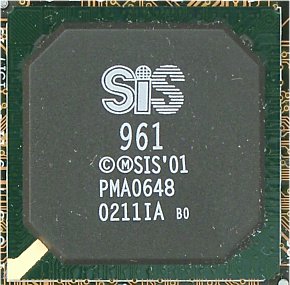 The SiS 645DX has nothing new, and there is officially no such memory as DDR400, but a wide support of processors, a low price of the chipset and an excellent performance achieved with the DDR400 make the SiS 645DX a real candidate for purchase. Intel 850EThis is the most mysterious chipset. The chipset supporting Rambus was released first for the new Pentium 4 line, but this is hardly a starting point of the triumphal procession, as it took place one and a half years ago. In the time of the Pentium III, when the slow and expensive RDRAM was kicked off by everyone, the new memory type was appreciated at its true value, and it required just few things - a new architecture of the Pentium 4 and its speed bus. Now it would be excellent to match the RDRAM with the 533MHz bus as well; fortunately, PC1066 samples are easily available now. Besides, the new south bridge ICH4 (aka I/O Controller Hub) supports 6 USB 2.0 ports. But… The market has its own laws. Intel failed to provide the base for the RDRAM, and an attempt to use a new expensive controller-hub to provide for the PC1066 support is not profitable when the most of Taiwanese manufacturers have no desire to redesign boards for the new chipset. They want the new chipset to be compatible with the old one in layout: the only change in the i850E as compared with the i850 is possible alterations to provide support for the 533MHz bus instead of the 400MHz one. Even the aging ICH2 remains here. 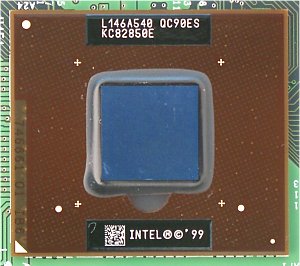 Above all, the new chipset has some problems of compatibility of some memory modules with the i850E. It concerns some modules with tRAC (Row Access Time) of 45 ns - with them the system can fail to start, but if it starts more problems won't occur. The complete list of checked and certified memory modules will be published at the Intel's site. Well, the only case when this chipset can probably be used is when someone wants to upgrade its computer without replacing the RDRAM modules. If you buy a system based on the Pentium 4 for the first time do not go with the i850E, though its performance level must be quite high. However, it will also depend on the memory prices. Performance testsTestbed:
Software:
There is no a separate description of the SiS SS51B board, we just think it's useless; you can take a look at its photo and its characteristics in the table. Note that its BIOS provides a wide range of settings; for example, you can set a memory frequency, independently of the FSB, up to the DDR400 support. It's interesting to compare two processor models with the same frequency as it allows us to estimate the gain of the new bus. The pairs are i850-i850E and SiS645-SiS645DX. The SiS chipsets are used with the DDR333 (overclocked to DDR400 as well), for the SiS 645DX we showed results of both boards because in some tests the reference one performs much better. There are also results for the VIA P4X266A platform — at the maximum level for this chipset. The scores of the Pentium 4 2.53 GHz are shown for the only interesting platform — SiS 645DX+DDR400. In all diagrams the Pentium 4 2.4 GHz has blue bars, the Pentium 4 2.4B GHz has yellow and orange ones and the Pentium 4 2.53 GHz is marked with green color. Test results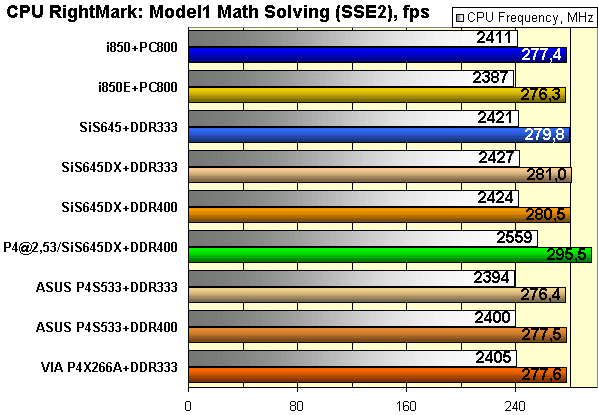 As we compare the processors of the same architecture, it is enough to use only one instruction set for the CPU RightMark: we chose SSE/SSE2. So, with the SSE2 all 2.4 GHz processors have the same scores with light deviations according to the real processor speed on a certain board. The Pentium 4 2.53 GHz is 5.3% ahead which means that the test is ideally (96%) scalable. 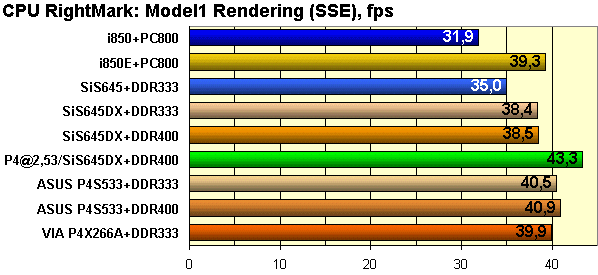 The overall system performance in the CPU RightMark (with the default settings) depends mostly on the rendering speed, while the equation solving unit only reduces the scores; that is why let's estimate only a speed of the rendering unit. The difference between the new and old processors is well noticeable, and there is no such between the systems on the DDR333 and DDR400. It means that in this test (at least, with the DDR333 and higher memory) the processor bus limits the performance. Different platforms based on the same processor have very close results, and it's impossible to define a leader. 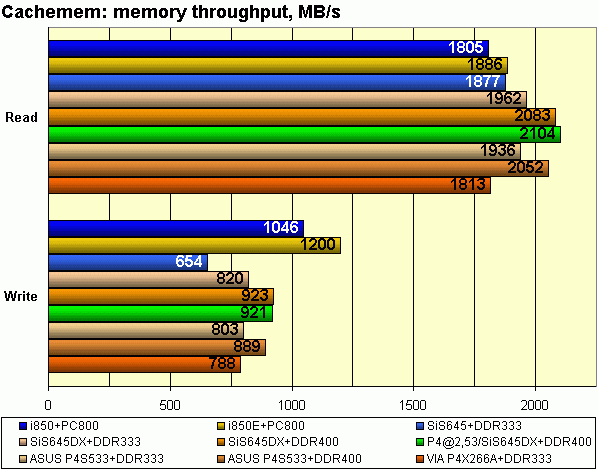 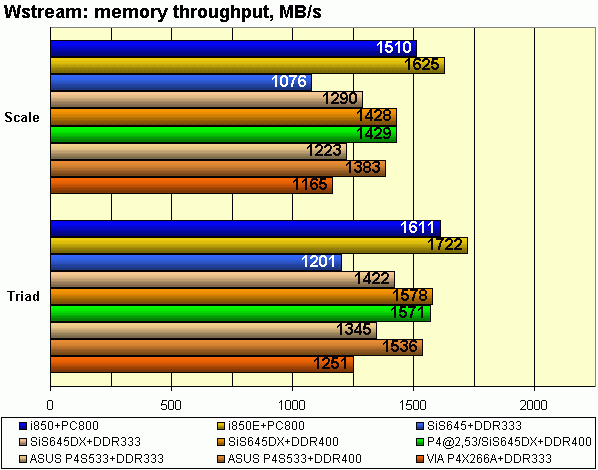 In the Cachemem and Wstream the situation is different: there is acceleration caused by increasing of the frequency of the processor and memory buses. The new SiS chipset outscores the others, including the i850E, in the memory read speed, and when coupled with the DDR400, it has a really great breakthrough. And it's not easy for the participants to catch up in the memory write speed even with the the i850 which comes with the RDRAM (PC800). As a result, in the Wstream the best performance in execution of the synthetic set of operation is shown by the pair of the 850th chipsets, though the SiS 645DX+DDR400 is not too far.  Note that the results of the i850 are obtained on the ASUS P4T-E board with not the best BIOS version (we showed it in the last review), that is why there is no any wonderful acceleration. In case of the other chipsets the performance depends not on a throughput of the memory or processor's bus but only on the CPU speed. 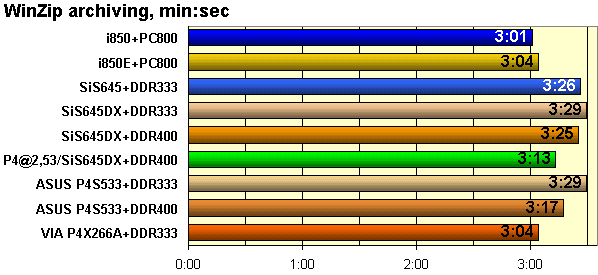 This test doesn't depend on a throughput of the memory or processor bus either, and it hardly reacts to increasing of the CPU speed. It is obvious that the speed of this test is limited by some other factor - maybe, by the IDE controller. 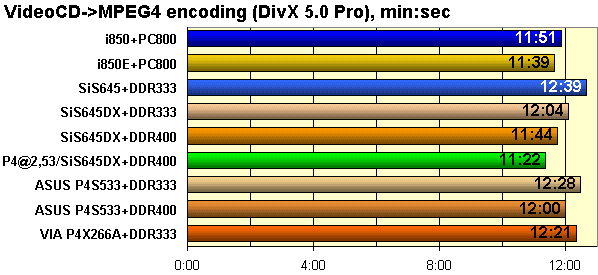 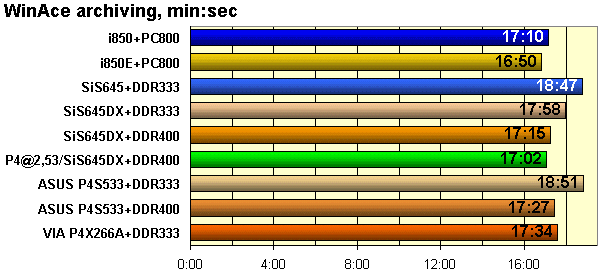 The MPEG4 encoding and WinAce archiving depend on the memory more than the other tests, and the results are very close to the synthetic Wstream. The first position is taken by the i850E, but the SiS 645DX+DDR400 is very close. The VIA's chipset is not impressing at all. Note also that the ASUSTeK's board loses to the SiS reference one. 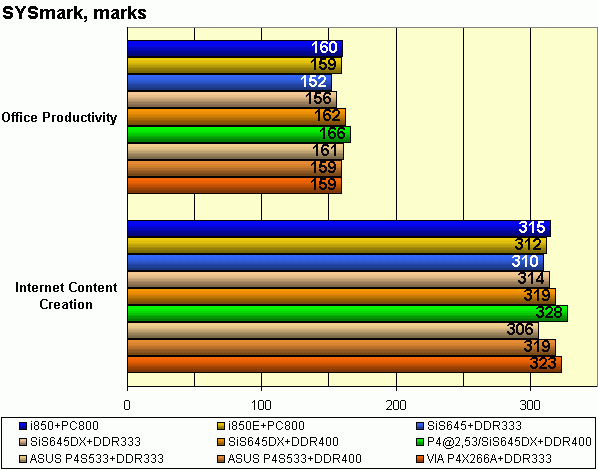 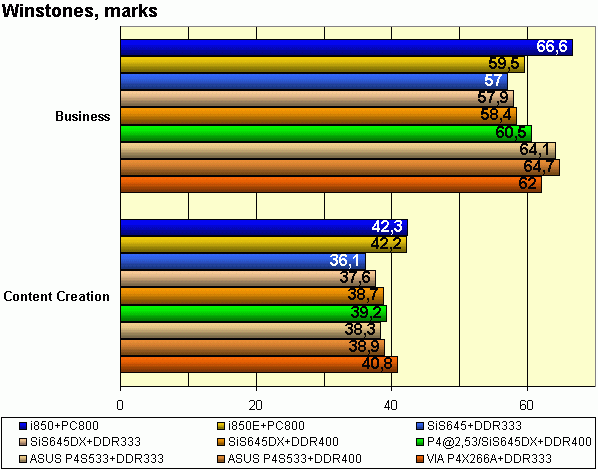 In the semisynthetic tests of the SYSmark the SiS 645DX outpaces the i850E when it is coupled with the DDR400; and the VIA P4X266A performs unexpectedly excellently. In the Content Creation Winstone it also has good scores. This is the last time when we use Business Winstone because it's impossible anymore to explain its results. 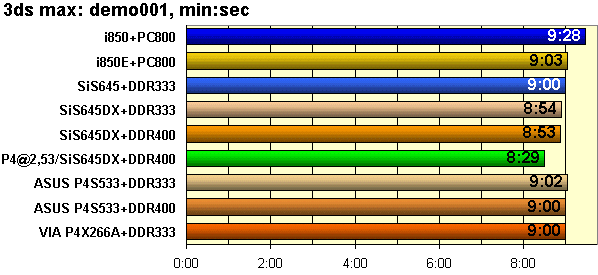 The rendering in the 3ds max is one more good processor test where other components hardly affect the performance. If we exclude the results of the i850, we will see that the test is defined by the CPU frequency.  We show the boards' results only for two tests of the professional OpenGL suite of the SPECviewperf: in the AWadvs-04, as well as in the ProCDRS, all platforms go on a par (the speed is limited by the video card and AGP), and in the other tests the results have a dependence character which completely coincides with the DRV-07. This is the dependence on the memory and a video accelerator's speed. The i850 and i850E are above all. 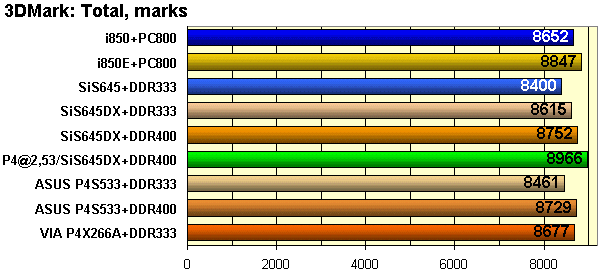 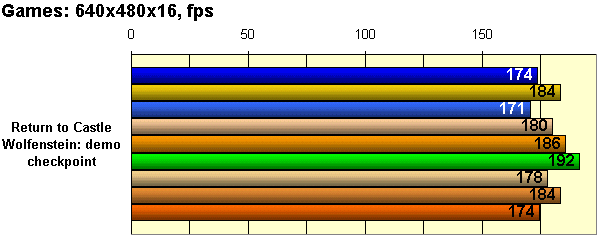 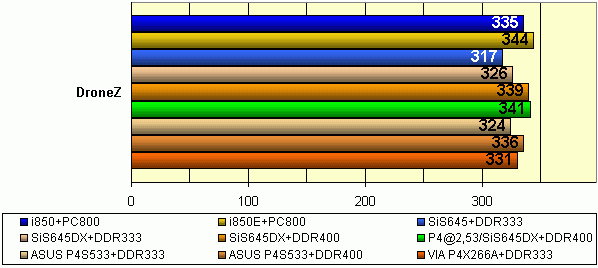 In the games the new 533MHz processors are faster than their predecessors — the average gain is 5-10%. The i850E is the best, the SiS 645DX is very close on the heels, and the VIA P4X266A falls behind though it outscores the SiS chipset when coupled with the DDR333. ConclusionWell, the new processors on the 533MHz bus are faster than their predecessors by 5-10%. It is not enough so that users want to upgrade their computers based on the Pentium 4 with the 400MHz bus. On the other hand, Intel is not going to maintain competition between its lines, and the old one will soon disappear from the scene, and until it does the prices for the models of the same frequency will be maintained approximately equal. As for the chipsets, there is no a definite leader. But soon Intel will release new products aimed at conquering the Future. To be continued...Write a comment below. No registration needed!
|
Platform · Video · Multimedia · Mobile · Other || About us & Privacy policy · Twitter · Facebook Copyright © Byrds Research & Publishing, Ltd., 1997–2011. All rights reserved. |